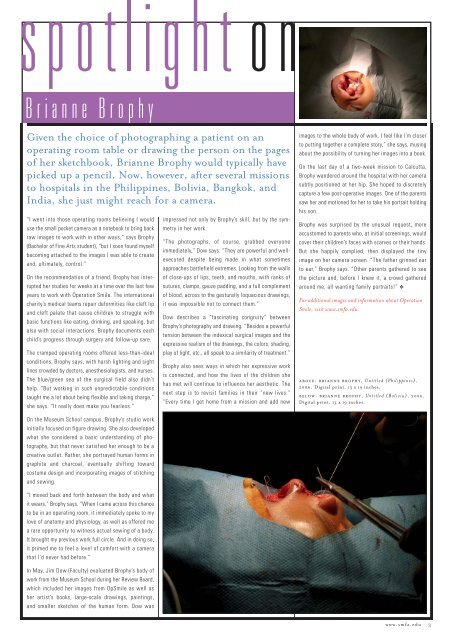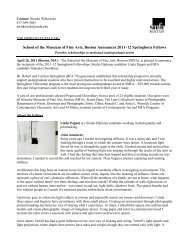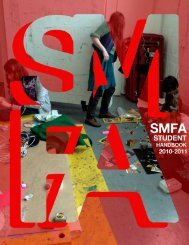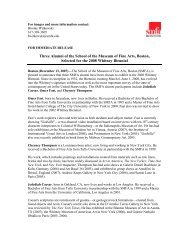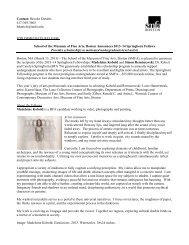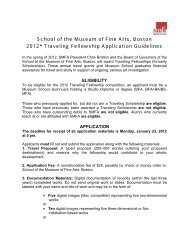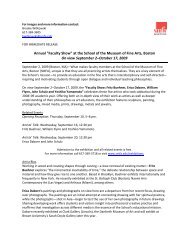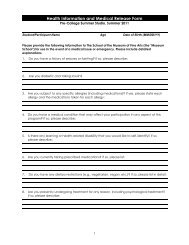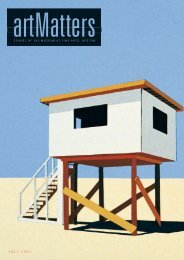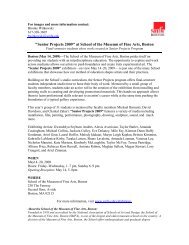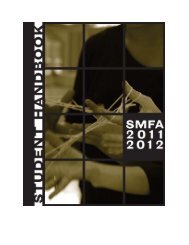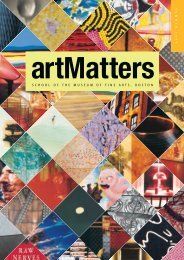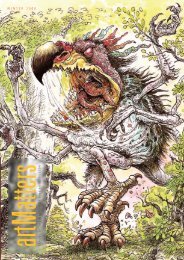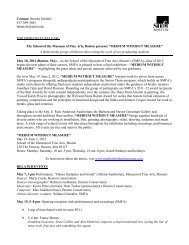41786 artMattersV2 - School of the Museum of Fine Arts
41786 artMattersV2 - School of the Museum of Fine Arts
41786 artMattersV2 - School of the Museum of Fine Arts
You also want an ePaper? Increase the reach of your titles
YUMPU automatically turns print PDFs into web optimized ePapers that Google loves.
Brianne Brophy<br />
Given <strong>the</strong> choice <strong>of</strong> photographing a patient on an<br />
operating room table or drawing <strong>the</strong> person on <strong>the</strong> pages<br />
<strong>of</strong> her sketchbook, Brianne Brophy would typically have<br />
picked up a pencil. Now, however, after several missions<br />
to hospitals in <strong>the</strong> Philippines, Bolivia, Bangkok, and<br />
India, she just might reach for a camera.<br />
“I went into those operating rooms believing I would<br />
use <strong>the</strong> small pocket camera as a notebook to bring back<br />
raw images to work with in o<strong>the</strong>r ways,” says Brophy<br />
(Bachelor <strong>of</strong> <strong>Fine</strong> <strong>Arts</strong> student), “but I soon found myself<br />
becoming attached to <strong>the</strong> images I was able to create<br />
and, ultimately, control.”<br />
On <strong>the</strong> recommendation <strong>of</strong> a friend, Brophy has interrupted<br />
her studies for weeks at a time over <strong>the</strong> last few<br />
years to work with Operation Smile. The international<br />
charity’s medical teams repair deformities like cleft lip<br />
and cleft palate that cause children to struggle with<br />
basic functions like eating, drinking, and speaking, but<br />
also with social interactions. Brophy documents each<br />
child’s progress through surgery and follow-up care.<br />
The cramped operating rooms <strong>of</strong>fered less-than-ideal<br />
conditions, Brophy says, with harsh lighting and sight<br />
lines crowded by doctors, anes<strong>the</strong>siologists, and nurses.<br />
The blue/green sea <strong>of</strong> <strong>the</strong> surgical field also didn’t<br />
help. “But working in such unpredictable conditions<br />
taught me a lot about being flexible and taking charge,”<br />
she says. “It really does make you fearless.”<br />
impressed not only by Brophy’s skill, but by <strong>the</strong> symmetry<br />
in her work.<br />
“The photographs, <strong>of</strong> course, grabbed everyone<br />
immediately,” Dow says. “They are powerful and wellexecuted<br />
despite being made in what sometimes<br />
approaches battlefield extremes. Looking from <strong>the</strong> walls<br />
<strong>of</strong> close-ups <strong>of</strong> lips, teeth, and mouths, with ranks <strong>of</strong><br />
sutures, clamps, gauze padding, and a full complement<br />
<strong>of</strong> blood, across to <strong>the</strong> gesturally loquacious drawings,<br />
it was impossible not to connect <strong>the</strong>m.”<br />
Dow describes a “fascinating congruity” between<br />
Brophy’s photography and drawing. “Besides a powerful<br />
tension between <strong>the</strong> indexical surgical images and <strong>the</strong><br />
expressive realism <strong>of</strong> <strong>the</strong> drawings, <strong>the</strong> colors, shading,<br />
play <strong>of</strong> light, etc., all speak to a similarity <strong>of</strong> treatment.”<br />
Brophy also sees ways in which her expressive work<br />
is connected, and how <strong>the</strong> lives <strong>of</strong> <strong>the</strong> children she<br />
has met will continue to influence her aes<strong>the</strong>tic. The<br />
next step is to revisit families in <strong>the</strong>ir “new lives.”<br />
“Every time I get home from a mission and add new<br />
images to <strong>the</strong> whole body <strong>of</strong> work, I feel like I’m closer<br />
to putting toge<strong>the</strong>r a complete story,” she says, musing<br />
about <strong>the</strong> possibility <strong>of</strong> turning her images into a book.<br />
On <strong>the</strong> last day <strong>of</strong> a two-week mission to Calcutta,<br />
Brophy wandered around <strong>the</strong> hospital with her camera<br />
subtly positioned at her hip. She hoped to discretely<br />
capture a few post-operative images. One <strong>of</strong> <strong>the</strong> parents<br />
saw her and motioned for her to take his portrait holding<br />
his son.<br />
Brophy was surprised by <strong>the</strong> unusual request, more<br />
accustomed to parents who, at initial screenings, would<br />
cover <strong>the</strong>ir children’s faces with scarves or <strong>the</strong>ir hands.<br />
But she happily complied, <strong>the</strong>n displayed <strong>the</strong> tiny<br />
image on her camera screen. “The fa<strong>the</strong>r grinned ear<br />
to ear,” Brophy says. “O<strong>the</strong>r parents ga<strong>the</strong>red to see<br />
<strong>the</strong> picture and, before I knew it, a crowd ga<strong>the</strong>red<br />
around me, all wanting family portraits!” ❖<br />
For additional images and information about Operation<br />
Smile, visit www.smfa.edu.<br />
above: brianne brophy, Untitled (Philippines),<br />
2006. Digital print. 13 x 19 inches.<br />
below: brianne brophy, Untitled (Bolivia), 2006.<br />
Digital print. 13 x 19 inches.<br />
On <strong>the</strong> <strong>Museum</strong> <strong>School</strong> campus, Brophy’s studio work<br />
initially focused on figure drawing. She also developed<br />
what she considered a basic understanding <strong>of</strong> photography,<br />
but that never satisfied her enough to be a<br />
creative outlet. Ra<strong>the</strong>r, she portrayed human forms in<br />
graphite and charcoal, eventually shifting toward<br />
costume design and incorporating images <strong>of</strong> stitching<br />
and sewing.<br />
“I moved back and forth between <strong>the</strong> body and what<br />
it wears,” Brophy says. “When I came across this chance<br />
to be in an operating room, it immediately spoke to my<br />
love <strong>of</strong> anatomy and physiology, as well as <strong>of</strong>fered me<br />
a rare opportunity to witness actual sewing <strong>of</strong> a body.<br />
It brought my previous work full circle. And in doing so,<br />
it primed me to feel a level <strong>of</strong> comfort with a camera<br />
that I’d never had before.”<br />
In May, Jim Dow (Faculty) evaluated Brophy’s body <strong>of</strong><br />
work from <strong>the</strong> <strong>Museum</strong> <strong>School</strong> during her Review Board,<br />
which included her images from OpSmile as well as<br />
her artist’s books, large-scale drawings, paintings,<br />
and smaller sketches <strong>of</strong> <strong>the</strong> human form. Dow was<br />
www.smfa.edu 3


